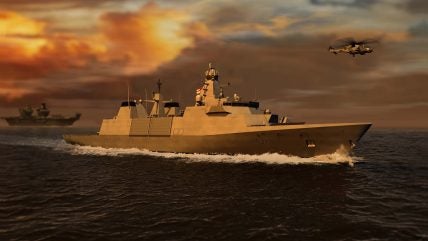
Babcock is progressing with the build of the UK Royal Navy’s Type 31 frigate at its Rosyth Shipyard in Scotland, with the hull form and superstructure of the first-in-class HMS Venturer substantially completed, according to the images posted in February.
Showcased in a 24 February Royal Navy release marking the formal affiliation of HMS Venturer with the English country of Essex, imagery shows the hull completed, along with much of the superstructure above deck. Additional systems such as the mast are yet to be installed, with the vessel due to remain in the covered build hall for some time to come.
The images in the Royal Navy release are the same as those posted by Babcock on social media platform X earlier in the month, where it disclosed that hull consolidation activities had been carried out at Rosyth to enable to weighing of HMS Venturer in order to perform validation checks.
Presenting its H1 2023 financial results late last year, Babcock stated that during the next financial year design activities “will be finalised” and the construction of HMS Venturer will be “substantially” complete.
It was recently reported by Naval Technology that the integration the Mk 41 vertical launch systems (VLS) into the 31 frigates could come in the form of capability insertion periods carried out after the vessel has been delivered to the Royal Navy, rather than carried out during the build process.
Capability insertion periods are undertaken around halfway through the ship’s initial service life, usually around 10-12 years.
The decision in May 2023 that the UK’s Type 31 frigates, originally envisaged as light patrol platforms, were to be fitted with the Lockheed Martin Mk 41 VLS system offered the prospect of a significant capability increase through a wider range of anti-ship and anti-air missiles.
Potentially, earlier vessels, such as HMS Venturer, could be completed as originally designed, with future ships in class incorporating the Mk 41 VLS during the construction phase.
This could create a two-variant class of Type 31 frigate, with older models initially delivered on a ‘fitted for but not with’ the Mk 41. This is relatively common among naval warship programmes, with variants created to fulfill specific roles, such as anti-ship warfare, as required.
Current status of the Type 31 frigate build
In the H1 2023 results report last year, Babcock outlined the progress that was being made on the Type 31 frigate programme, stating the first-in-class HMS Venturer was “progressing through construction” with the ship’s superstructure “taking shape”.
In addition, the main engines, gear boxes, and diesel generators had been installed, with the next major milestone of HMS Venturer being the float-off, expected in the first half of 2024. Manufacture of the second ship in class, HMS Active, has seen the first double bottom block completed in the build cradle, following the keel laying earlier in 2023.
The Type 31 build is intended to deliver five general purpose frigates into Royal Navy service to replace five outgoing, and ageing, Type 23 vessels.
According to the UK’s shipbuilding programme, five Type 31 Inspiration-class general-purpose frigates will be introduced into Royal Navy service from 2027, with Babcock completing the handover of the fifth and final vessel the following year.








